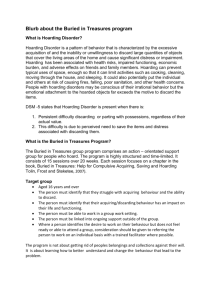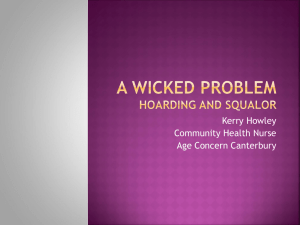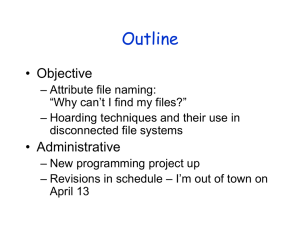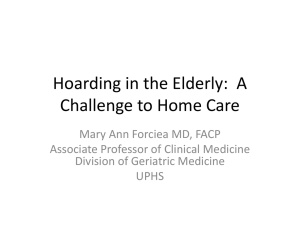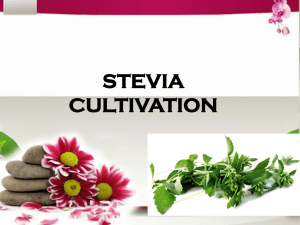Hoarding: The Impact of Compulsive Keepers Leader’s Guide Denise Dias Lesson Objectives
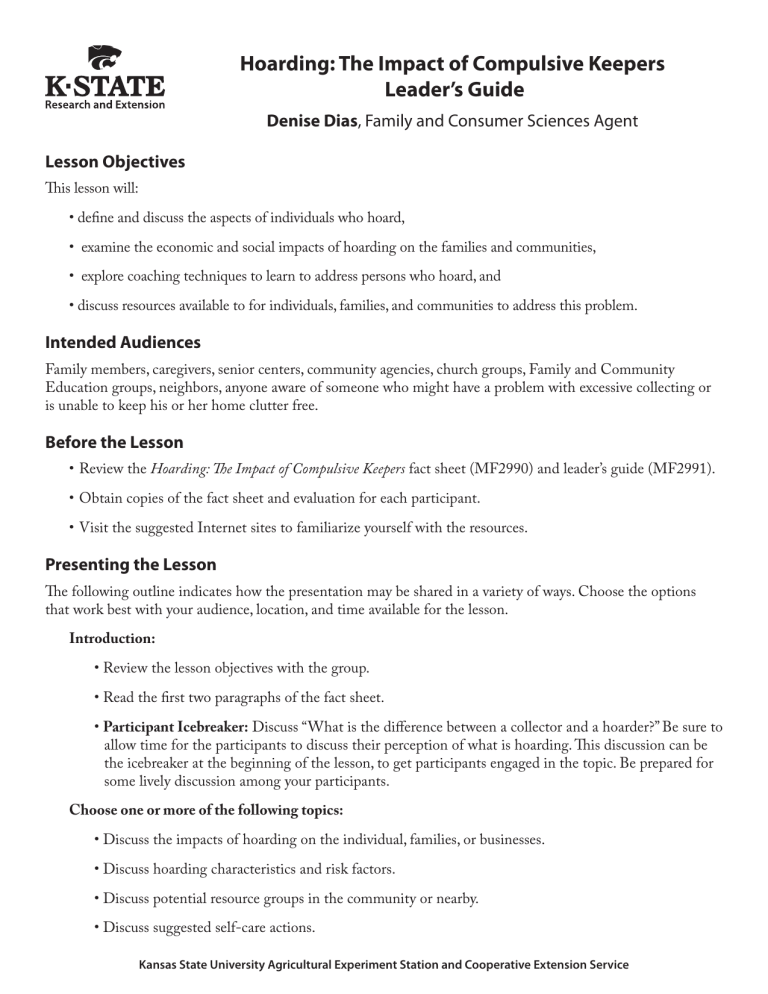
Hoarding: The Impact of Compulsive Keepers
Leader’s Guide
Denise Dias, Family and Consumer Sciences Agent
Lesson Objectives
This lesson will:
• define and discuss the aspects of individuals who hoard,
• examine the economic and social impacts of hoarding on the families and communities,
• explore coaching techniques to learn to address persons who hoard, and
• discuss resources available to for individuals, families, and communities to address this problem.
Intended Audiences
Family members, caregivers, senior centers, community agencies, church groups, Family and Community
Education groups, neighbors, anyone aware of someone who might have a problem with excessive collecting or is unable to keep his or her home clutter free.
Before the Lesson
• Review the Hoarding: The Impact of Compulsive Keepers fact sheet (MF2990) and leader’s guide (MF2991).
• Obtain copies of the fact sheet and evaluation for each participant.
• Visit the suggested Internet sites to familiarize yourself with the resources.
Presenting the Lesson
The following outline indicates how the presentation may be shared in a variety of ways. Choose the options that work best with your audience, location, and time available for the lesson.
Introduction:
• Review the lesson objectives with the group.
• Read the first two paragraphs of the fact sheet.
• Participant Icebreaker: Discuss “What is the difference between a collector and a hoarder?” Be sure to allow time for the participants to discuss their perception of what is hoarding. This discussion can be the icebreaker at the beginning of the lesson, to get participants engaged in the topic. Be prepared for some lively discussion among your participants.
Choose one or more of the following topics:
• Discuss the impacts of hoarding on the individual, families, or businesses.
• Discuss hoarding characteristics and risk factors.
• Discuss potential resource groups in the community or nearby.
• Discuss suggested self-care actions.
Kansas State University Agricultural Experiment Station and Cooperative Extension Service
• Have the group consider some of the possible community awareness activities listed below.
Guest speaker: Invite a guest speaker to discuss this topic with your group. Possible speakers could include someone from a local mental health association, a professional organizer, or someone from the local humane society.
Share experiences: Ask attendees to view a TV show or read a book on hoarding and have a group discussion about it.
Conclusion: Remind participants of the lesson objectives.
• Distribute the evaluation, thank the participants, and close the session.
Community Awareness Activities
• Organize and participate in a neighborhood night out event to get to know others around you.
• Share the information with another group or agency that could benefit from this information.
• Create and set up a display at a community event that explains what hoarding is and identify what local resources are available.
• Attend a conference on hoarding to learn what local stakeholders are doing to address this problem. Each spring the Wichita/Sedgwick County Hoarding Coalition hosts a conference.
www.sedgwickcounty.org/hoarding
• Network with community members to start a coalition of people interested in addressing this problem.
Resources
For more information:
Hoarding Coalition, Wichita/Sedgwick County, www.sedgwickcounty.org/hoarding
Mayo Clinic/Health Information/Diseases/Symptoms, www.mayoclinic.com/health/hoarding/DS00966
Institute for Challenging Disorganization, www.challengingdisorganization.org
International OCD Foundation Hoarding Center, www.ocfoundation.org/hoarding/
Examples of potential resource groups and agencies that might be involved:
• Professional Organizers Association, www.napo.net/
• Area Agencies on Aging and Senior Centers
• Adult Protective Services – SRS
• Animal Services and Shelters
• Fire Department
• Housing and Community Services
• Police Department
• Code Enforcement
• Environmental Resources
Author
Denise Dias, Family and Consumer Sciences Agent, K-State Research and Extension – Sedgwick County
Reviewers
Carol Young, Family Financial Management Specialist, K-State Research and Extension
Sarah Taylor, Family and Consumer Sciences Agent, K-State Research and Extension – Sedgwick County
Hoarding: the Impact of Compulsive Keepers — Evaluation
Date of Program: _______________
Program Location (County or District): ________________________________________________
I learned that (circle all that apply):
• Hoarding is a compulsive disorder.
• People who hoard:
• are perfectionists;
• have trouble making a decision and distress that it might not be the right decision;
• Cleaning up the mess is the worst thing a concerned person can do.
• Often family members do not make good coaches for people who hoard.
• Other _______________________
• have a poor sense of time and often miss deadlines.
• People who hoard face health and safety risks.
• Effective treatment of hoarding can take up to a year with long-term support.
• To assist people who hoard, it’s best to listen to needs without being judgmental.
• People who hoard can affect the workplace and reduce productivity.
• Agencies and groups exist that can help people who hoard.
• Other _______________________
I will: (Circle all that apply)
• Be more sensitive when others are critical of people who hoard.
• Focus on the good qualities of people who hoard, not the mess.
• Recognize small steps of progress when people struggle with eliminating clutter.
• Reach out to those in the community who appear isolated.
• Seek to learn more information about hoarding.
• Seek to learn about resources to help people who hoard.
• People who hoard need community understanding and support.
• Good coaches help to shape the decision; they do not make the decision for people.
• Take small steps to improve the clutter management in my home.
• Other_____________________
Collect and mail to: Denise Dias, 7001 W. 21st Street N, Wichita, KS 67205
Brand names appearing in this publication are for product identification purposes only. No endorsement is intended, nor is criticism implied of similar products not mentioned.
Publications from Kansas State University are available at: www.ksre.ksu.edu
Publications are reviewed or revised annually by appropriate faculty to reflect current research and practice.
Date shown is that of publication or last revision. Contents of this publication may be freely reproduced for educational purposes.
All other rights reserved. In each case, credit Denise Dias, Hoarding: The Impact of Compulsive Keepers, Leader’s Guide,
Kansas State University, August 2011.
Kansas State University Agricultural Experiment Station and Cooperative Extension Service
MF2991 August 2011
K-State Research and Extension is an equal opportunity provider and employer. Issued in furtherance of Cooperative Extension Work, Acts of May 8 and June 30, 1914, as amended. Kansas State University, County Extension Councils, Extension Districts, and United States Department of Agriculture Cooperating, Gary Pierzynski, Interim
Director.
